All to often, walking the City of London it is too easy to get depressed with how much character is being lost. At street level much recent development looks the same. Standard materials, bland architecture and design that could equally be at home in Shanghai, Dubai or New York.
Fortunately there are still many places that retain that sense of being part of London’s history and where character remains.
For this week’s post I want to explore one such area, Wardrobe Place and St. Andrews Hill, both can be found off Carter Lane, which runs parallel to Queen Victoria Street and Ludgate Hill / St. Paul’s Churchyard, to the south-east of St. Paul’s Cathedral.
This area is part of the St. Paul’s Cathedral Conservation Area, one of the City Conservation Areas where special planning controls are in force to manage development within the area. The document covering the St. Paul’s Conservation Area is an interesting read and can be downloaded here.
Unlike much of the City to the south, east and north of St. Paul’s Cathedral, this area did not suffer from the extensive fire damage caused by bombing during the last war, and has had limited major development in the decades since.
Walk down Carter Lane from St. Paul’s and on the left you will find the entrance to Wardrobe Place, an alley through the line of buildings along the street.
At the end of the alley, the view opens up to Wardrobe Place, enclosed by buildings on all four sides with the main entrance being the alley into Carter Lane.
From this perspective, the buildings on the left are relatively recent developments, it is the buildings on the right that are off interest as a surviving post Great Fire development.

Immediately to the right is No. 2 Wardrobe Place. This is a Grade II listed building from around 1680. The listing states that “the house retains its late-C17 domestic plan and stair, panelling and other original or early features. The two overmantel paintings have outstanding interest as early examples of a once-widespread artisan tradition, and are now of great rarity.”
The paintings refer to two original wall paintings that were discovered during building work in the 1970s.
The exterior of the building has later alterations with the stucco windows and the round-headed frame around the door from 1860, however the building is still essentially a London town house from the post fire redevelopment of London.

Next along are numbers 3 to 5 Wardrobe Place. These are from around 1715, three broadly similar, three bay town houses. 
Look closer at these buildings and they retain features essential to living and working in London in the past.
On No. 4, inset just to the right of the front door is a foot scraper. A device essential to cleaning shoes prior to entering a building. London’s streets are today relatively immaculate compared to a time when filth was commonplace, thousands of horses worked across the City streets and efficient waste removal was limited.
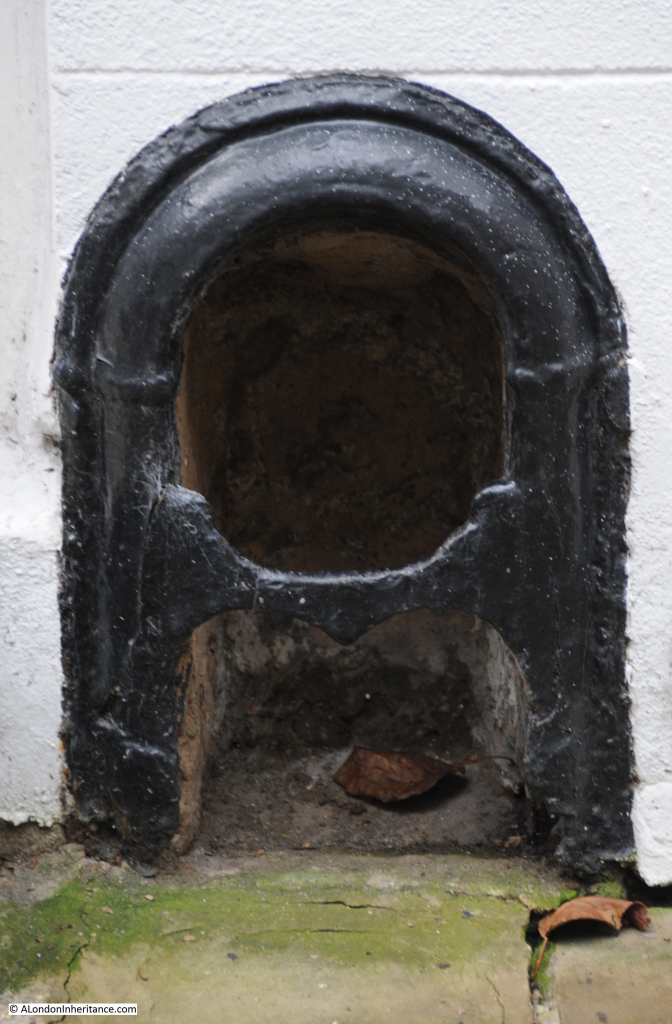
Also on No. 4 are two bell pushes, either side of the front door. Not easy to see after many layers of black paint, but the one of the left is for the Office and the one on the right for the Housekeeper. 
Wardrobe Place is so named as up until the Great Fire of 1666, it was the site of the King’s Wardrobe (the storage, administration and expenditure office for the King). The Wardrobe was moved here from the Tower in the 1360s into the mansion owned by Sir John Beauchampe. From Stow’s Survey of London:
“Then is the kings greate Wardrobe, Sir John Beauchampe, knight of the Garter, Constable of Dover, Warden of the Sinke Portes builded this house, was lodged there, deceased in the yeare 1359. His Executors sold the house to King Edware the third”.
The Wardrobe name does not give away the intrigue that must have taken place here, for according to Stow:
“The secret letters and writings touching the estate of the Realme, were wont to be enroled in the Kings Wardrobe, and not in the Chauncery, as appeareth by the records”.
Today, there is a plaque recording the earlier function of this area:
And on the later buildings at the far end are the remains of a sign recording the buildings previous use and occupier:
SNASHALL & SON
Printers. Stationers &
Good to see that this sign has been preserved. There are too few of these remaining across the City. Signs which once must have been on almost every City building.
The view from the far end looking back up towards the Carter Lane entrance. The buildings on the right are part of a 1980s development which at least retained some of the architectural character of Wardrobe Place.
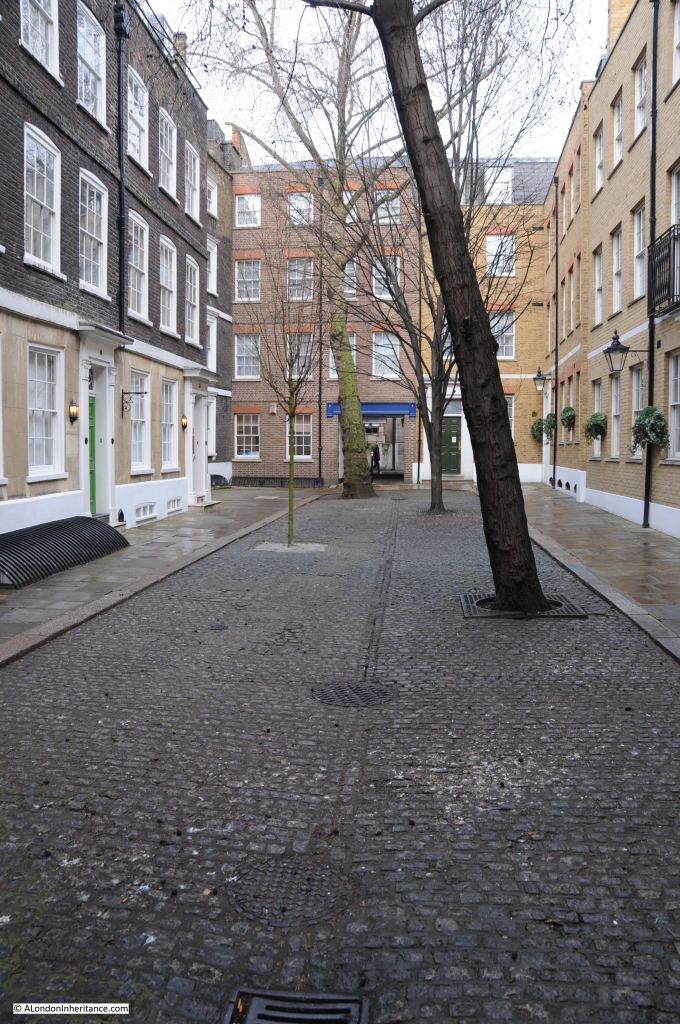
Now walk back into Carter Lane and a short distance further we come to St. Andrews Hill. This leads down to Queen Victoria Street, opposite where Puddle Dock was originally located and according to George Cunningham in his 1927 Survey of London, was originally called Puddledock Hill (although I have been unable to find any other reference that confirms this, however it could well have been an earlier or alternative name as the street leads up from both Puddle Dock and the church of St. Andrew’s by the Wardrobe.)
The street displays the characteristic downward slope towards the river.

And one of the many boundary markers that can still be found across the City:
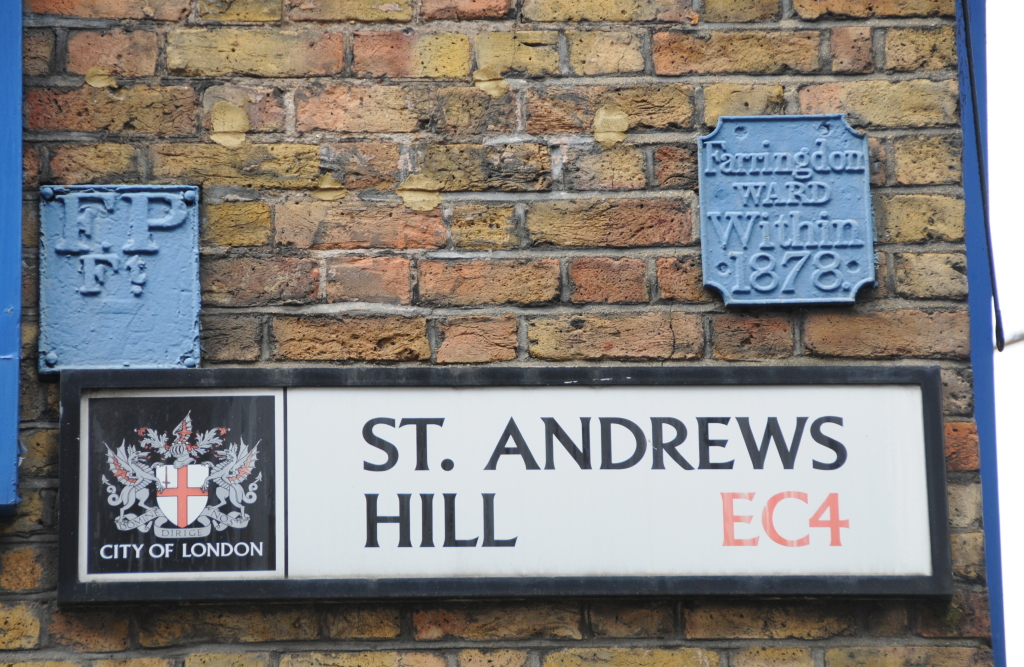 Many of the buildings along St. Andrews Hill are 19th century in origin and a mix of style and function including offices, shop fronts and warehouses.
Many of the buildings along St. Andrews Hill are 19th century in origin and a mix of style and function including offices, shop fronts and warehouses.
In front of the listed 36 St. Andrews Hill are two Post Office letter boxes, not now in use, but unusual, 100-year-old survivors.
The box on the left is Edward VII (1901 – 1910) and on the right is George V (1910 – 1936)
And just past the letter boxes is St. Andrews House with a strange first floor, corner bay window:
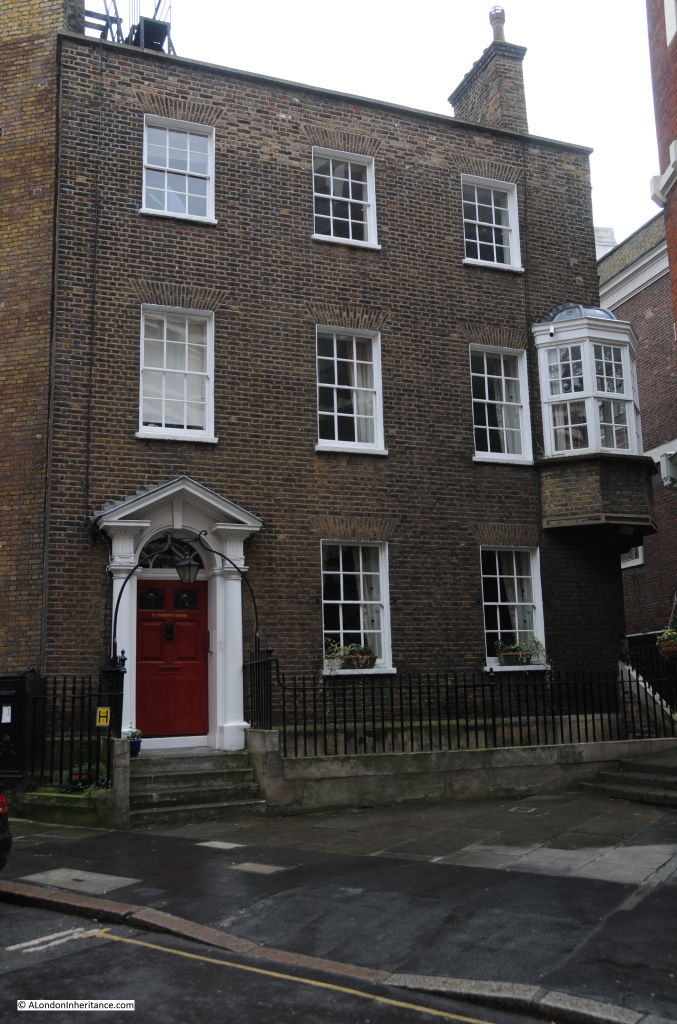 And just past St. Andrews House are alleys around the church of St. Andrew by the Wardrobe:
And just past St. Andrews House are alleys around the church of St. Andrew by the Wardrobe:
Also in St. Andrews Hill is the excellent Cockpit Pub:
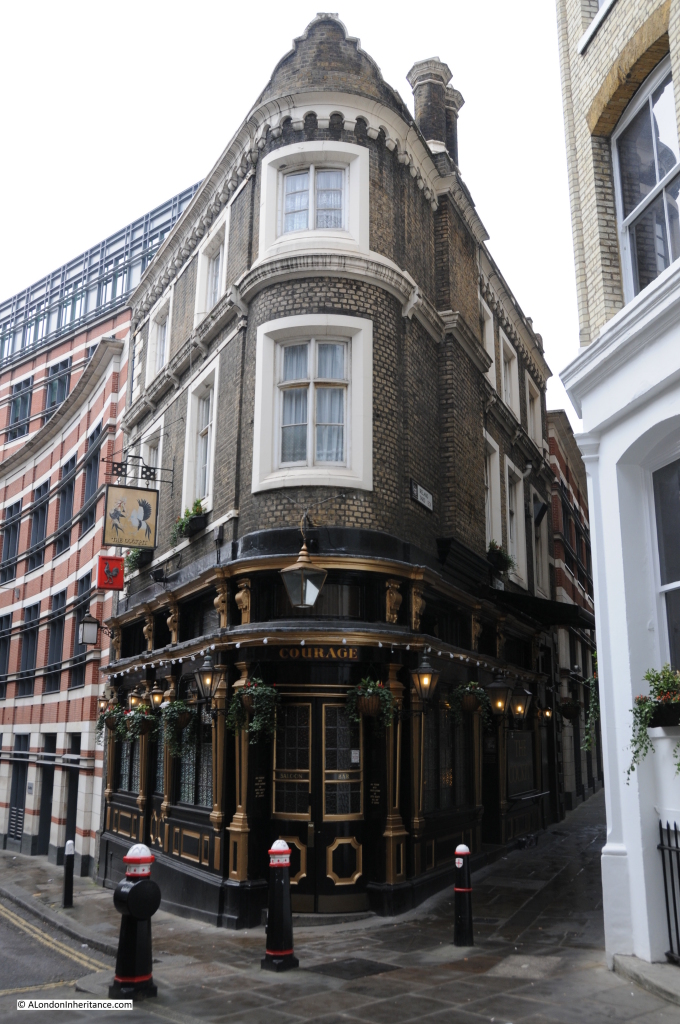 A fascinating shape being on both St. Andrews Hill and Ireland Yard. The current building is mainly from 1842, however a pub is alleged to have been here from the 16th century and the name is a reference to cock-fighting and the associated gambling that once took place here.
A fascinating shape being on both St. Andrews Hill and Ireland Yard. The current building is mainly from 1842, however a pub is alleged to have been here from the 16th century and the name is a reference to cock-fighting and the associated gambling that once took place here.
Wardrobe Place and St. Andrews Hill, not significant historical locations, but thankfully places where it is still possible to get a glimpse of the development of City streets from after the Great Fire through to the 20th Century.




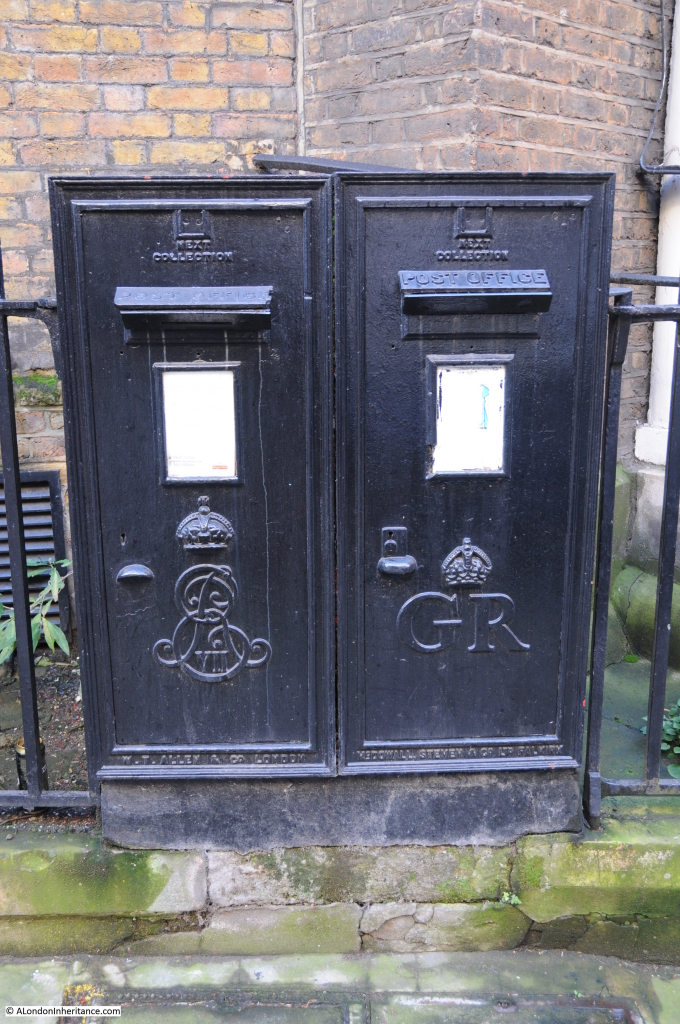
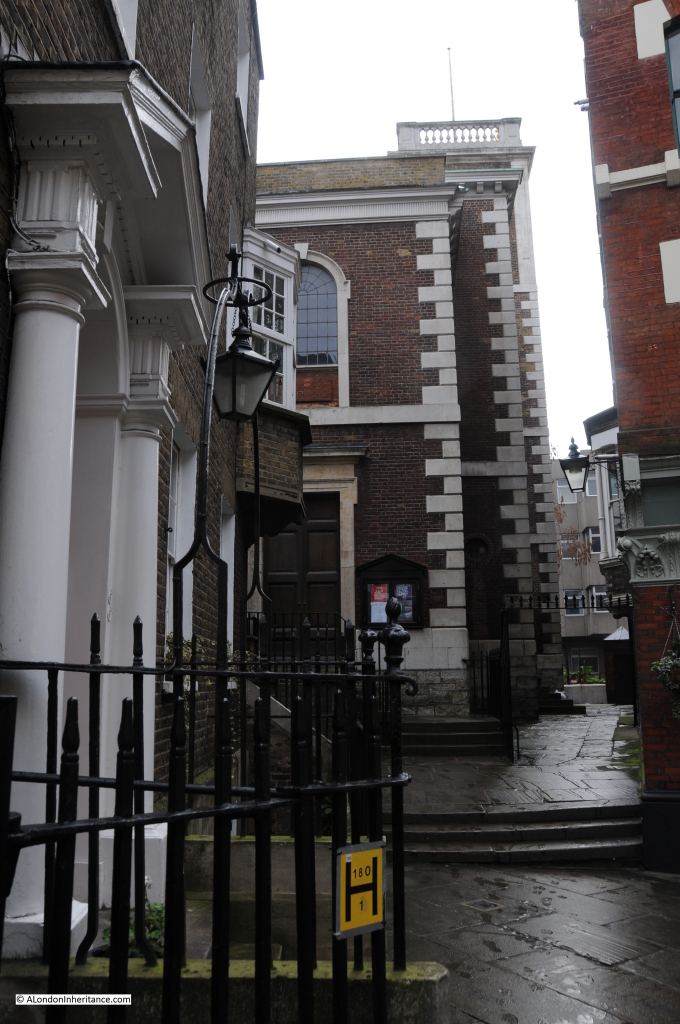
Your blog posts are excellent, thoroughly enjoyed this one. Great pictures too.
Thanks Vicky. Really appreciate the feedback.
Hello, thanks for the blog, very interesting. I have just returned from a walk around this area, whilst on a work break. Found it by accident, was struck by the character of the streets and buildings.
I worked in Wardrobe Place in 1967/68 and loved it there. I go back every time I visit London. Sadly most of it was empty on my last visit. I used to work for a solicitor called Michael Broome and the firm was Beer & Co. I have very happy memories of working in this place.
Thank you for these photos.
Dear Mrs Matthewson.
I’ve been looking for Beer & Co online for a while now & cannot find anyone who is able to provide any information on this firm.
I have a letter belonging to my late Father from Beer & Co 5a Wardrobe Place, Carter Lane.
Dated 8th December 1965 with an agreement number & a reference to them acting on behalf of Silver Mist Investments Ltd – I’m really hoping you may be able to help me, I’m sure they moved or ceased trading by now but need to resolve the matter as my Dad had an investment with them which we no nothing of.
If you see this message please would you contact via email or I can provide a mobile number on request.
Many thanks. Mrs Alison Lloyd.
On my way to work (from Gray’s Inn Road to Angel Lane) this morning (25 April 2018), I briefly wandered around this area. I will return soon armed with this excellent guide. Thank you!
I was intrigued by the church of St. Andrew-by-the-Wardrobe, which is closed, perhaps unused, possibly awaiting improvements to the building. On the QVS side of the church there is a plaque commemorating improvements to the churchyard carried out in 1901. The masonry structure on which the plaque is mounted is in a poor state of repair – I am wondering if this is due to bomb damage.
I returned last night to visit Wardrobe Place. The footscraper of No.4 is broken, but other features mentioned remain intact. I was interrupted by a City guide with his entourage in tow.
Sorry but I ‘m afraid I can’t help you. Mr Beer was not a young man when I worked there. I imagine the firm changed name or just folded. There is a legal requirement to keep documents for a certain period so they could be lodged in a vault somewhere. Might be easier to trace the shares by name. Good luck!
Alison – you could try Companies House
Excellent, worked in Faraday building nearby for 20 years and we did our initial training in Wardrobe Court, many fond memories of this part of City
Great to read this, brought back many memories. I worked at the Observer when it was in St Andrews Hill in the early 70s. That building has amazingly gone, replaced by something else. But the Cockpit is still there, and long may it remain. Liam the Irish landlord used to serve the best Guinness in London. Happy days!
Feel free to add this if of interest: “O.T. & O.L. Snashall were manufacturing stationers based here in the 1920s and 1930s. This was once one of a pair of signs, both by the same signwriter, but ‘1st Door on Left’ is all that survives of the lower one.”